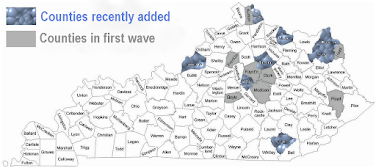Study to find best ways to prevent opioid overdoses has started testing and interventions in second and last group of 8 counties

Kentucky Health News map shows counties in study; click it to enlarge.
—–
By Elizabeth Chapin
University of Kentucky
The $87 million study to find the best ways to battle the opioid epidemic at the local level in Kentucky is expanding to more communities across the state.
The second wave of the University of Kentucky’s HEALing Communities Study was launched in Bourbon, Campbell, Carter, Greenup, Jefferson, Jessamine, Knox and Mason counties on July 1. The communities will implement new recovery, treatment and prevention strategies proven to reduce opioid-overdose deaths.
Launched in 2019 with a federal grant, the four-year study has tested ways to reduce OD deaths in Boyd, Boyle, Clark, Fayette, Floyd, Franklin, Kenton and Madison counties. Starting in 2020, a multidisciplinary team of more than 25 UK researchers worked with local and state behavioral-health and criminal-justice agencies.
Their evidence-based practices include delivery of medication for opioid-use disorder, reducing risky prescribing, education on how to prevent overdoses, and distribution of naloxone, a lifesaving drug that reverses opioids’ effects.
 |
| Sharon Walsh, Ph.D. |
In the second group of eight counties, “The HEALing Communities Study will bring life-changing outreach and access to treatment to thousands of Kentuckians,” said HCS principal investigator Sharon Walsh, a professor in UK’s College of Medicine and College of Pharmacy and director of the Center on Drug and Alcohol Research.
The second wave of counties includes community engagement to assist key stakeholders in applying evidence-based practices and a communications campaign to build demand for treatment and reduce stigma toward people with opioid-use disorder. The HCS team is also working with various pharmacies and health care providers to implement safer opioid prescribing and dispensing.
The first group of counties are now in a sustainability phase, which is intended to build capacity to help community coalitions and partner organizations sustain the evidence-based practices after the study ends.
HCS researchers will analyze data from all 16 counties, using pre-intervention usual care in the group as a control element. The comparison will show how evidence-based practices work in different settings in each community. The second-wave intervention is expected to end in early 2024.